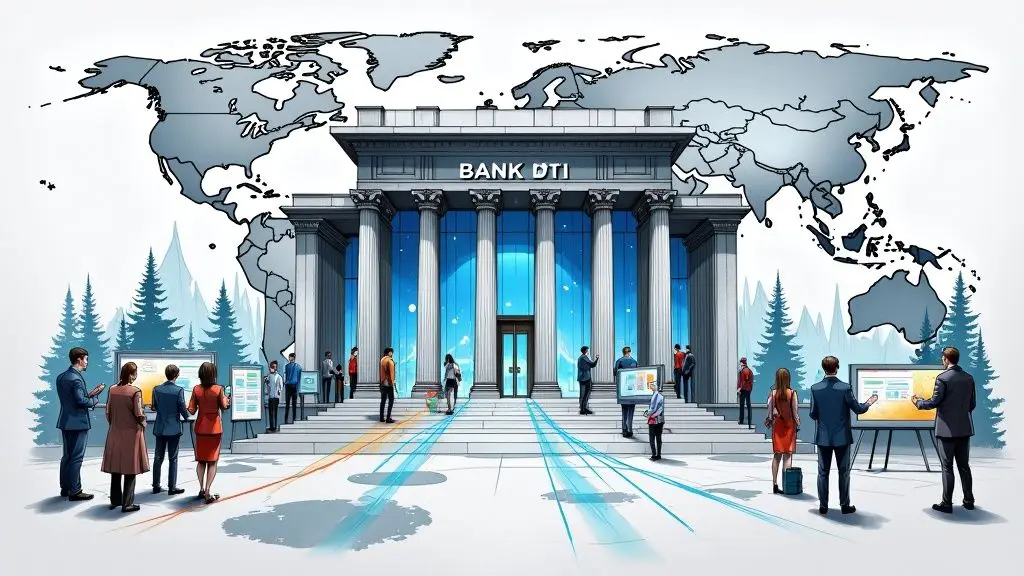Digital Transformation in Banking: How Financial Leaders Are Reinventing the Industry

Understanding the Digital Banking Revolution
Banks worldwide are racing to modernize their systems and services as customer needs evolve and new competitors emerge. While many banks are investing heavily in new technologies and digital services, the path to successful transformation isn’t straightforward. The key question becomes: what makes some banks succeed in their digital initiatives while others struggle to make meaningful progress?
The Success Rate of Digital Transformation in Banking
The numbers tell a sobering story – only about 30% of banks successfully complete their digital transformation projects. This means that most banks face significant hurdles in modernizing their operations and services. One common issue is focusing too much on implementing new technology without properly preparing employees to use it effectively. It’s similar to giving someone keys to a high-performance car without teaching them how to drive – the potential benefits remain locked away without the right skills and understanding.
Key Metrics for Measuring Transformation Success
To properly evaluate digital banking initiatives, banks need concrete ways to measure real progress. Here are the essential metrics that matter:
- Cost-to-Income Ratio: Banks that successfully modernize typically see major improvements in this metric through automated processes and more efficient operations
- Customer Retention Rates: Better digital services often lead to happier, more loyal customers who are less likely to switch banks
- Operational Efficiency Gains: Digital tools help reduce manual work and processing times, allowing staff to focus on more valuable activities like helping customers
- Customer Acquisition Costs: Smart digital marketing and seamless onboarding can significantly reduce the expense of bringing in new customers
Frameworks for Measuring Success
Leading banks use comprehensive measurement systems that look beyond just financial metrics. These frameworks examine multiple aspects of performance, including customer satisfaction scores, internal process improvements, and staff development. This balanced approach helps ensure that technology investments directly support the bank’s core business goals and strategy. Think of it like using a GPS system – you need clear markers and constant course correction to reach your destination successfully.
Regular customer feedback is also essential throughout the modernization process. By actively listening to what customers want and need, banks can fine-tune their digital services to better serve their market. This focus on customer input helps banks build services that people actually want to use, rather than just chasing the latest technology trends.
Learning From Global Digital Banking Champions
Some banks have mastered the shift to digital services while others still find it challenging. Looking at successful examples from places like Nordic countries and South Korea reveals practical insights that banks worldwide can apply to improve their own digital offerings.
Decoding Nordic Digital Banking Dominance
Finland stands out with an impressive 95% of customers using digital banking services regularly. This high adoption stems from several key factors working together: excellent internet infrastructure across the country, a population comfortable with technology, and banks that consistently deliver easy-to-use digital tools. As a result, most Finnish customers naturally choose digital options for their daily banking needs.
Norway shows similarly strong digital banking usage. Like Finland, their success comes from smart government policies supporting technology adoption and a society that readily embraces new digital solutions. Both countries have built environments where digital banking simply makes sense for most people – it’s convenient, reliable, and well-supported.
South Korea: A Tech-Forward Banking Powerhouse
South Korea offers another compelling example, with 91% of customers using digital banking. Their banks excel by combining advanced technology with an intense focus on what customers actually want and need. South Korean banks put significant effort into creating mobile apps and online services that people genuinely enjoy using. They carefully design these tools to be both powerful and simple to navigate.
Emerging Markets: Leapfrogging Legacy Systems
In many developing countries, banks are taking an interesting shortcut – skipping traditional banking infrastructure and going straight to mobile solutions. This is especially clear in Brazil and India, where many people’s first experience with banking is through their phones. These markets often have an advantage: without old systems holding them back, they can implement the newest technology much faster.
For older banks with existing systems, this presents an interesting lesson. While established banks often struggle to update their older technology, they can learn from how newer markets build simple, focused digital services. This might mean gradually adopting cloud systems or building more flexible technology structures that can evolve over time.
Key Takeaways for Digital Transformation in Banking
Studying these success stories reveals several important principles:
- Customer-Centric Approach: Focus first on making banking easier and better for customers
- Technological Innovation: Invest in reliable, modern technology that serves real customer needs
- Agility and Adaptability: Stay flexible enough to adjust services as customer needs change
- Ecosystem Development: Build strong support systems, including infrastructure and helpful policies
Banks can improve their digital services by focusing on these core ideas. Success requires more than just new technology – it needs a complete rethinking of how banks serve their customers.
Navigating the Post-Pandemic Banking Landscape
The banking sector experienced a dramatic shift during the global pandemic as customers rapidly adopted digital banking services out of necessity. This wasn’t a temporary change – it permanently changed how people interact with their banks. Traditional banks quickly realized they needed to move beyond basic online services to create complete digital-first experiences that truly serve modern customer needs.
Turning Crisis into Opportunity: The Rise of Contactless and Omnichannel Banking
The urgent need for safe, contactless banking sparked real innovation. For instance, MCB Bank in Pakistan launched digital account opening, letting customers handle everything remotely – a perfect example of meeting immediate needs while building for the future. Banks also accelerated their omnichannel strategies, connecting mobile apps, websites, branches and ATMs into one smooth customer experience. This shift showed how banks could adapt quickly when needed.
Rethinking Digital Readiness in the New Normal
Success in this new environment requires a fresh look at what makes a bank truly ready for digital service. It’s not just about having modern technology – banks need to understand exactly what their customers want and need. Key areas to focus on include:
- Resilience: Your systems must handle usage spikes without failing. Regular stress testing and robust infrastructure are essential.
- Security: More digital banking means more security risks. Strong protections for customer data build trust.
- Personalization: Customers expect services tailored to them. Smart use of data and AI helps deliver personal experiences.
Building a Customer-Centric Digital Future
To succeed after the pandemic, banks must put customers first in everything they do. This means creating digital services that add real value, not just moving paper processes online. Key strategies include:
- Seamless Onboarding: Make it quick and easy to open accounts and start banking digitally. Cut unnecessary steps and paperwork.
- Intuitive User Interfaces: Design mobile apps and websites that are simple and clear. If customers find them hard to use, they won’t stick around.
- Proactive Customer Support: Use AI chatbots and targeted communication to solve problems before customers even ask.
Banks also need to foster ongoing innovation throughout their organization. This means staying flexible, regularly testing new technologies, and making sure staff have the right training to serve customers effectively in this digital age. By focusing on these fundamentals, banks can turn today’s challenges into opportunities to grow and better serve their customers.
Breaking Through Digital Transformation Banking Barriers
Most US banks are falling behind in their digital progress – a concerning 62% report they’re either lagging or barely keeping pace with technological changes. While the opportunities are clear, many banks struggle to move forward. Let’s examine the key obstacles holding banks back and practical ways to overcome them.
Legacy Systems and the Weight of the Past
The reality of working with outdated systems creates major headaches for banks trying to modernize. Picture trying to connect a modern mobile banking app to a core system from the 1980s – it’s like forcing puzzle pieces from different sets to fit together. These aging systems weren’t built for today’s digital services, leading to disconnected data, technical conflicts, and spiraling costs when banks attempt upgrades. For many institutions, the foundation simply isn’t strong enough to support their digital goals.
Regulatory Compliance: Navigating the Shifting Sands
Banks face an extra challenge that many industries don’t – constantly changing regulations around data privacy, security, and financial crime prevention. Meeting these requirements while pushing forward with digital projects takes significant time and money. Banks often find themselves diverting resources to compliance technology that could have funded other improvements. This balancing act between innovation and regulation frequently slows down progress and makes long-term planning difficult.
Building Internal Capabilities: Cultivating a Digital Mindset
New technology alone won’t drive success – banks need people who know how to use it effectively. This means investing in training programs to build digital skills across the organization. But beyond technical abilities, banks need to foster an environment where trying new approaches is encouraged and missteps are viewed as learning opportunities. When employees feel empowered to experiment and adapt, digital transformation has a much better chance of taking root.
Managing Change Resistance: Embracing the New
People naturally tend to stick with what they know, and banking employees are no exception. Those who’ve spent years mastering traditional processes often hesitate to adopt new ways of working. This resistance shows up in various ways – from quietly avoiding new tools to actively working against changes. The key is helping employees see clear benefits for themselves and their customers, while maintaining open communication and actively involving them in the transformation process.
Using AI and Automation for Better Results
Forward-thinking banks are finding success by thoughtfully applying artificial intelligence and automation. AI helps personalize customer experiences and spot risks early, while automation reduces manual work so employees can focus on more valuable activities. For example, AI chatbots now handle routine customer questions 24/7, and automated systems catch fraudulent transactions in real-time.
By tackling these core challenges head-on – from technical barriers to human factors – banks can build momentum in their digital evolution. Success requires looking at both the technology and people sides of change. With sustained focus on improvement and adaptation, banks can better serve their customers’ changing needs while staying competitive in an increasingly digital banking environment.
Capturing Opportunities in Emerging Markets
While digital banking has evolved significantly in developed countries, some of the most interesting innovations are actually happening in developing economies. These markets, with their large populations of unbanked people and minimal traditional banking presence, have become testing grounds for new digital banking solutions. This creates both complex challenges and unique opportunities for established banks looking to expand globally.
Leapfrogging Traditional Banking: The Mobile-First Approach
In developing regions, mobile phones serve as the primary gateway to both internet and financial services. This reality has sparked a mobile-first approach to banking that skips the need for extensive physical branches. Take India, for example – the combination of affordable smartphones and initiatives like Aadhaar, the country’s biometric ID system, has driven rapid adoption of mobile banking and digital payments. Brazilian digital banks are seeing similar success by offering simple account opening and user-friendly apps that appeal to previously unbanked customers. This ability to bypass older systems means these markets can adopt new technologies more quickly and cost-effectively.
Addressing Unique Challenges in Emerging Markets
Success in these regions requires carefully navigating several key factors:
- Financial Literacy: Many customers are new to formal banking. Digital solutions need to be simple and intuitive enough for first-time users to understand easily.
- Connectivity and Infrastructure: While mobile phone usage is widespread, internet access can be spotty. Banks need solutions that work well even with limited connectivity.
- Regulatory Landscape: Rules around digital financial services are still developing in many markets. Banks must stay on top of changing regulations and ensure full compliance.
- Cultural Nuances: Understanding local preferences is essential. This could mean offering services in multiple languages or adding features that reflect local cultural practices.
Strategies for Success in Emerging Markets
To tap into the growth potential of these markets, banks should focus on:
- Partnerships with Local Players: Working with local fintech companies, mobile carriers, and community groups provides valuable market insights and customer connections.
- Localized Product Offerings: Creating financial products that match local needs is crucial. This might include small loans, mobile savings accounts, or insurance designed for informal workers.
- Investing in Digital Literacy Programs: Teaching consumers about digital banking helps drive adoption and builds trust in these services.
- Using Data and AI for Personal Service: Analyzing customer data to provide relevant recommendations helps keep customers engaged and loyal.
Digital banking in emerging markets requires more than just copying successful models from developed countries. It takes deep understanding of local conditions and dedication to building solutions that work for everyone. By focusing on customer needs and tackling local challenges head-on, banks can drive growth while helping more people access financial services.
Building Your Digital Banking Transformation Roadmap
A solid plan for modernizing banking services requires careful attention to both strategy and execution. Success comes not just from adding new technology, but from creating a clear path forward based on your bank’s unique needs and goals. Let’s explore how to build an effective roadmap that will guide your bank’s evolution.
Defining Your Digital Vision and Objectives
Start by getting crystal clear on where you want your bank to be in the next five years. What specific experience do you want customers to have when they interact with your services? Your vision should naturally flow from your core business strategy while meeting evolving customer expectations. If you aim to become your region’s top mobile banking provider, focus first on mobile features and engagement. Take this vision and break it down into concrete goals that are specific, measurable, achievable, relevant and time-bound (SMART).
Conducting a Comprehensive Needs Assessment
Take a detailed look at your current situation – much like a doctor examining a patient before treatment. Evaluate your existing systems, identify skills your team needs to develop, and gather customer feedback about pain points and unmet needs. This assessment reveals both strengths to build on and gaps to address. For example, if customers consistently struggle with your mobile app, prioritize improving its usability in your roadmap.
Prioritizing Initiatives and Allocating Resources
Now that you understand both your goals and current capabilities, determine which projects will most improve customer experience and business results. Consider the investment required, technical feasibility, and expected returns. A mobile app upgrade might deliver better ROI than a new CRM system. Once you’ve ranked initiatives by impact, assign the budget, people and technology needed for successful implementation.
Developing a Phased Implementation Plan
Think of digital transformation as an ongoing journey rather than a destination. Breaking it into smaller phases lets you test approaches, learn from results, and adjust plans based on real feedback. For instance, you might test a new digital account opening process at one branch before expanding it network-wide. This measured approach makes large-scale change more manageable.
Building a Culture of Continuous Innovation
Lasting transformation requires shifting how your organization thinks about change. Create an environment where teams feel empowered to try new approaches, provide regular training to build digital skills, and recognize both major wins and small victories. Help employees embrace new technologies and adapt alongside customer needs. Like successful tech companies that constantly refine their products, digitally mature banks should always be learning and evolving.
Looking to own your data and amplify your impact? Milemarker provides comprehensive solutions tailored for wealth management firms, helping improve data control, efficiency, and revenue management. Learn more at Milemarker.



